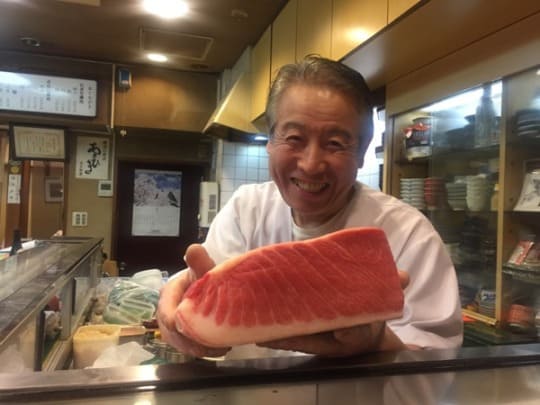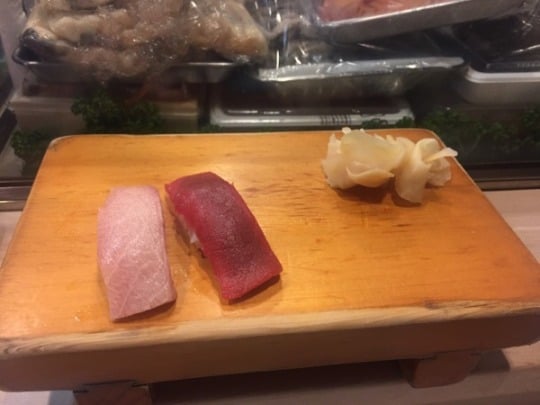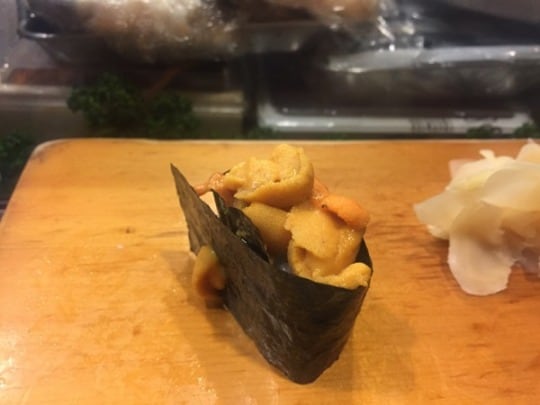I'll be blogging a lot more about my recent trip to Japan with Kaizen Institute, including the site visits and our lessons learned.
I had a few days of tourist / vacation time in Tokyo before and after the trip, which included getting to spend some time with a college friend who is currently doing some research at a Tokyo university. He taught me a great “Kaizen” lesson about introducing some visiting family members to sushi.
I love sushi, along with most other kinds of Japanese cuisine. Sushi is hardly an everyday food in Japan. One evening, a small group of us from the tour were able to visit a small neighborhood sushi restaurant near Shinagawa in Tokyo. Our sushi chef was amazing, as was his food:

The challenge that many people have, of course, is that sushi is generally raw fish, as seen below:

Like many people, I started off eating California rolls, a relatively mild (if not bland) combination of crab (or fake crab meat), cucumber, and avocado. The first time I ever had any sushi was at about age 25 and I think I didn't venture past basic rolls at that point.
Eventually, I developed a taste for sashimi and sushi, including various types of raw fish. I don't care for octopus (it's generally too chewy), but I surprised myself back in 2012 by trying uni (sea urchin) and really enjoying it. My rule of thumb while in Japan was to try at least a bite of anything that was put in front of me.

So, I made my progression from California rolls to tuna sushi to more adventurous sushi (uni, mussels, clam, raw shrimp) over time.
Listen to Mark read this post (subscribe to the podcast):
My college buddy had family members visiting who didn't want to eat sushi at all. He took them to a different sushi restaurant where the chef's approach seemed a lot like Kaizen to me.
With a Kaizen approach to improvement, we usually get started with small baby steps. Any small improvement is fine because it gets the ball rolling. As Masaaki Imai wrote about in his 1986 book Kaizen, an important first step with Kaizen is to get people participating and building enthusiasm for improvement and their participation. We're not likely to have people find million dollar ideas from the start and we shouldn't pressure people for ROI or cost savings. As a hospital CEO said in 2012, the best way to find ideas with a big impact is to find and implement lots of ideas.
As UCLA professor Robert Maurer wrote, in his book The Spirit of Kaizen, getting started with baby steps is an effective strategy for getting people to accept and embrace change. He uses an example of telling patients to start exercising 45 minutes a day. This seems overwhelming and the “fight or flight” instinct kicks in, usually leading people to not even try exercising. But, if you ask them to start by walking in place one minute per day, that's no longer overwhelming… they're more likely to start and they're more likely to increase their exercise levels to something more intensive that leads to weight loss. Listen to my podcast interview with him.
So, the sushi chef started my friend's family with broiled sushi, or what was essentially a fully-cooked piece of fish. Below, you can see my sushi chef broiling some fish (and I've also seen it done using a culinary torch).

Broiled sushi, pictured below (you can see scorched / charred edges).

My friend's family would happily eat the fully-cooked fish.
The chef then gave them a piece that was slightly less cooked — still broiled on the edges, but “medium rare” on the inside. They happily ate and enjoyed that piece as well, taking a “baby step” toward raw sushi.
Here's a picture of a slightly-broiled fish from another place I visited, see how it's just slightly scorched and how the color has changed just a bit:

Back to their story, my friend's family had a few more pieces that followed, each incrementally less cooked than the last.
Finally, came a piece of raw fish, which my friend's family tried… and realized they liked it. They went from “not liking the idea of raw fish” to being “OK with it within 30 minutes,” said my friend.
Think of that sushi chef's intentional strategy and think about applying that in the workplace. How many times do we fail because we try to force people to immediately jump to raw fish? Would we do better by starting with incremental baby steps, showing people that something new can be a positive, leading them through baby steps to WANT, or at least be comfortable with, the change? If my friend's family didn't even want to try, they wouldn't have been there at the sushi restaurant (they could have gone out for teppanyaki, izakaya, or another type of Japanese food).
I still think the best strategy is to get people to implement changes they want, solving problems they want to solve, rather than trying to force change on others through an incremental baby steps strategy.
Read more posts from the 2012 and 2014 Japan Tours
New Course with Jim Benson:
Come join me and Jim to learn about “personal kanban” and “kaizen” next month in San Francisco – great for people from any industry! Learn more and register. We've taught this together a few times in Seattle and San Antonio for people from healthcare, government, retailing, education, and software companies.
Please scroll down (or click) to post a comment. Connect with me on LinkedIn.
Let’s work together to build a culture of continuous improvement and psychological safety. If you're a leader looking to create lasting change—not just projects—I help organizations:
- Engage people at all levels in sustainable improvement
- Shift from fear of mistakes to learning from them
- Apply Lean thinking in practical, people-centered ways
Interested in coaching or a keynote talk? Let’s start a conversation.











[…] We always enjoy hearing about unique ways kaizen ideas have been used both in and outside the workplace. This week, we came across an example of kaizen thinking in a sushi restaurant, courtesy of Mark Graban’s Lean Blog. […]